Just last month, in June, 3Shape’s Discover event saw the release of its latest intraoral scanner (IOS), the TRIOS Core, and an updated TRIOS 3.
It’s only right that iDD compares these IOS alongside the rest of the TRIOS line-up, TRIOS 4 and TRIOS 5, Medit’s i900, and Dentsply Sirona’s CEREC Primescan, to see just how well 3Shape’s TRIOS IOS family compares.
I scanned the same 24 and 25 crown prep with six different scanners on the same day:
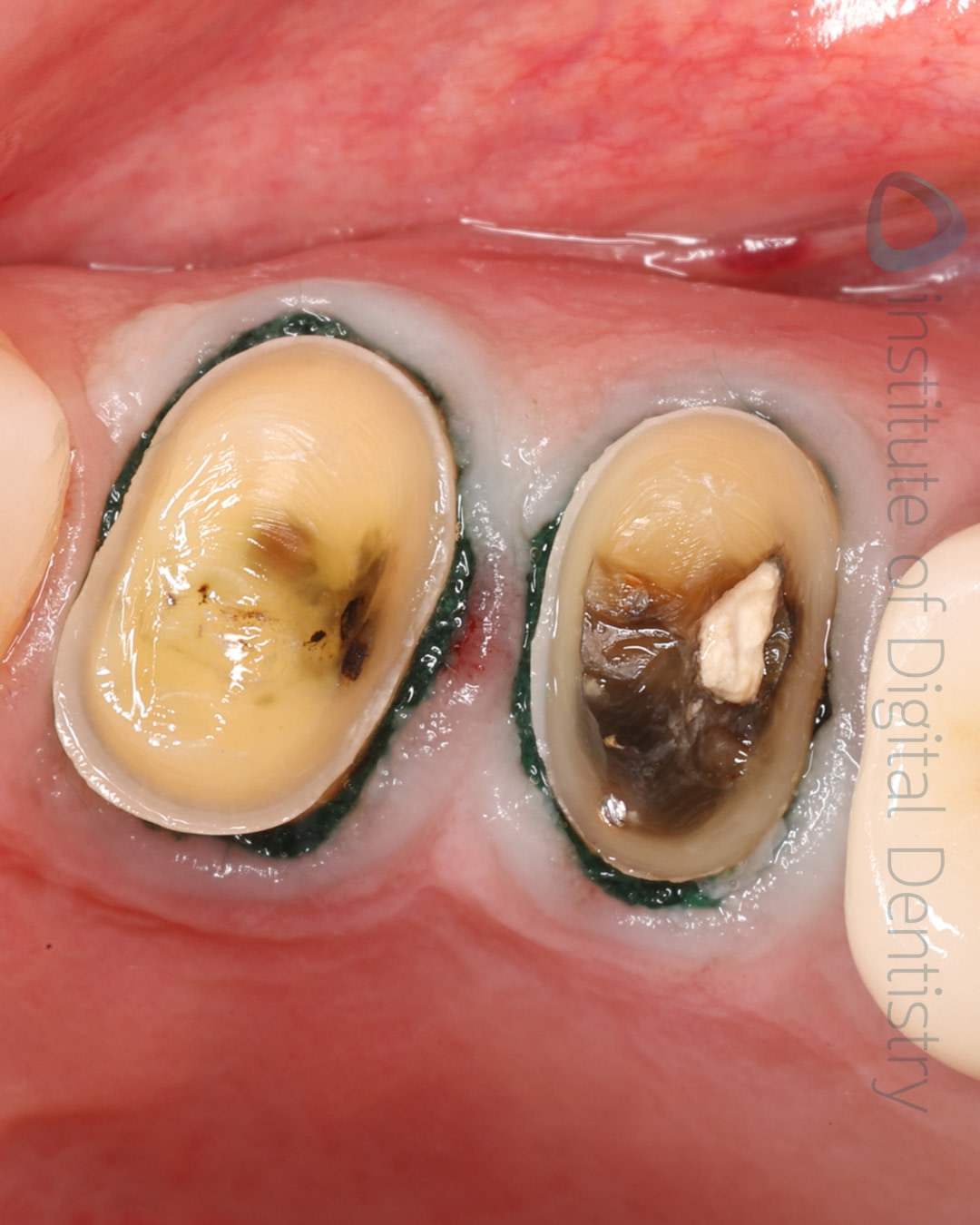
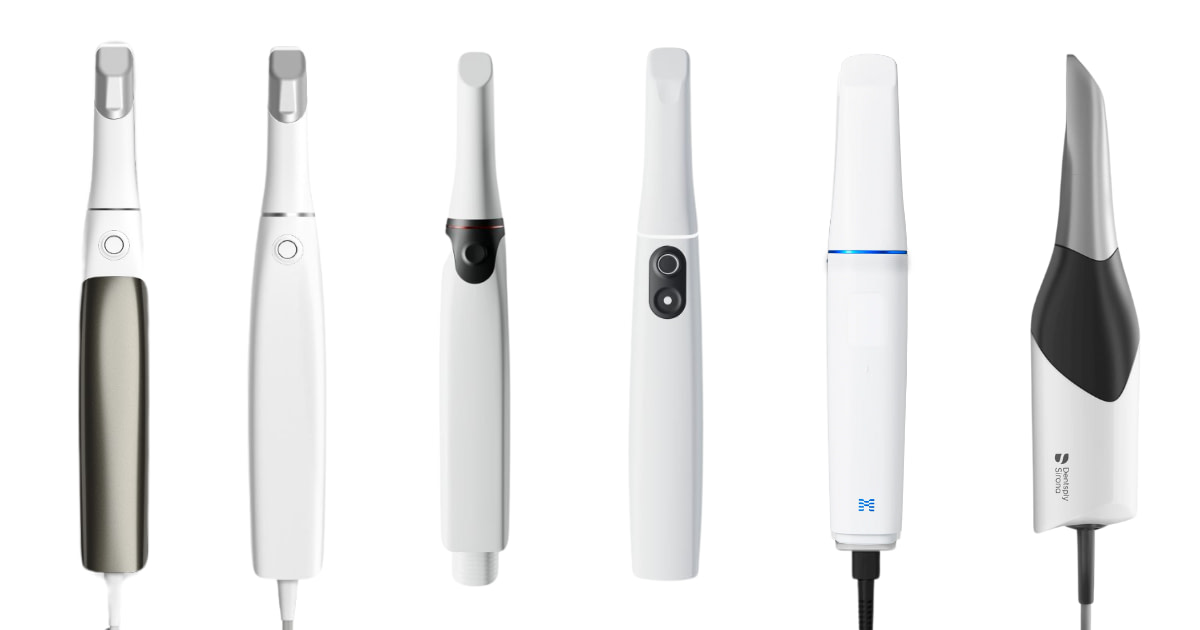
From left to right: TRIOS 3 Updated, TRIOS Core, TRIOS 4, TRIOS 5, Medit i900, and CEREC Primescan.
Stay informed about the latest in digital dentistry and follow iDD on all our social media platforms. You can also subscribe to our newsletter so you don’t miss out on our upcoming iDD Compares posts, product reviews, and industry announcements.
Keep reading to discover more about 3Shape’s latest IOS’ and the results of the individual scans - pictures of the color scan, exported STLs, tessellated mesh, and a close-up of the prep margin.
3Shape Discover Event Recap
The 3Shape Discover event was big - you can read our full recap here.
The company announced news that we think will have a large impact on the intraoral scanner market, namely:
An Updated TRIOS 3 - the Invisalign connection is that important.
TRIOS Core – brand-new and the lowest cost TRIOS intraoral scanner yet - built on TRIOS 3.
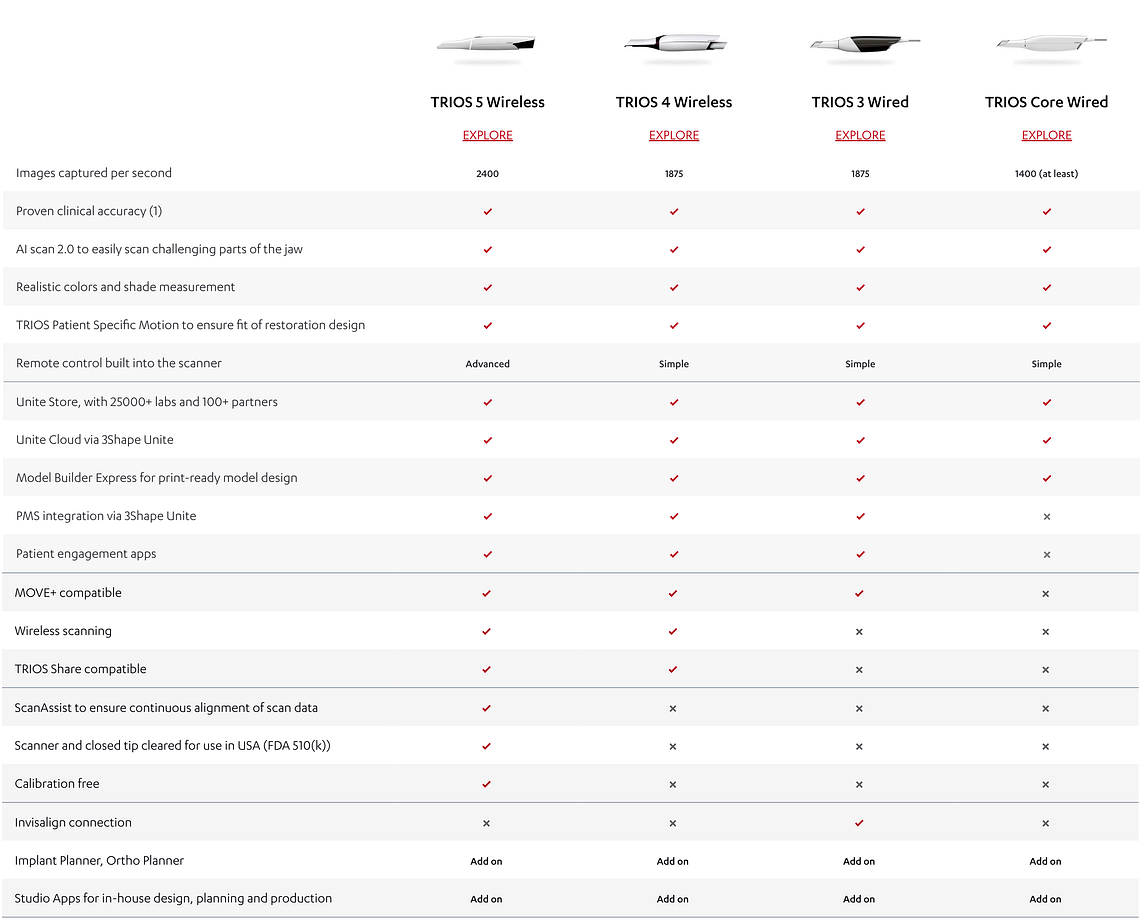
Updated TRIOS 3
3Shape has updated the TRIOS 3 intraoral scanner, which was originally released in 2015, with a new 'Twilight Titanium' color, improved cooling, redesigned scanner button, and a smaller, lighter pod powered by USB-C.
The main hardware remains unchanged, but these updates allow 3Shape to continue offering TRIOS 3 compatibility with Invisalign in certain regions outside North America, China, and Japan.
Priced at €16,900 or $17,400 USD, the updated TRIOS 3 maintains its wired configuration, requires calibration, uses autoclavable tips, and weighs 340 grams, while the wireless version is being phased out in favor of TRIOS 4 and TRIOS 5 models.
A New 3Shape Intraoral Scanner - TRIOS Core
3Shape has introduced the TRIOS Core, a simplified and more affordable version of the TRIOS 3 intraoral scanner, priced at 12,400 Euro/USD, aimed at dentists who primarily want to scan and send to labs.
While sharing much of the same hardware as the TRIOS 3, the TRIOS Core has a lower image capture rate, lacks patient management system integration, Move+ compatibility, patient engagement apps, and Invisalign integration.
This release indicates 3Shape's strategy to compete in the economic end of the market.
It offers a fully open scanner with TRIOS quality at a lower price point for budget-conscious dentists or those seeking a basic scan-and-send option.
Individual Scans in their Native Software
Every intraoral scanner has its own scanning software.
Almost all scanners can remove scan artifacts such as movable soft tissue, cheeks, and tongue through AI, with some performing better than others.
Interestingly, each scanner software captures color (called texture) differently. Below, you can see what the native scan images look like for each scanner.

The processed, colored scans of the same tooth preparation were captured using six scanners previewed in their native software.
CEREC has always had a more 'cartoon-like' scan aesthetic rather than being very life-like. In saying that it also routinely has a very crisp and sharp looking image. Medit also is not photo-realistic, but has more of a real-life image.
With all the TRIOS scanners, the captured scans are 'photo-realistic' across the board with some IOS varying in brightness - such as TRIOS 4 seemingly the brightest however not as bold in hue, whereas TRIOS 3 Updated, Core and 5 display more detail as the hue shows more detail and definition.
We can also see CEREC Primescan, displays a more saturated, yellow hue than the i900 which has the classic Medit texture - good resolution and sharp margins.
Monochromatic scans can also be taken and previewed in their native software. By looking at scans in monochrome, one can get a better view of the prep's quality.
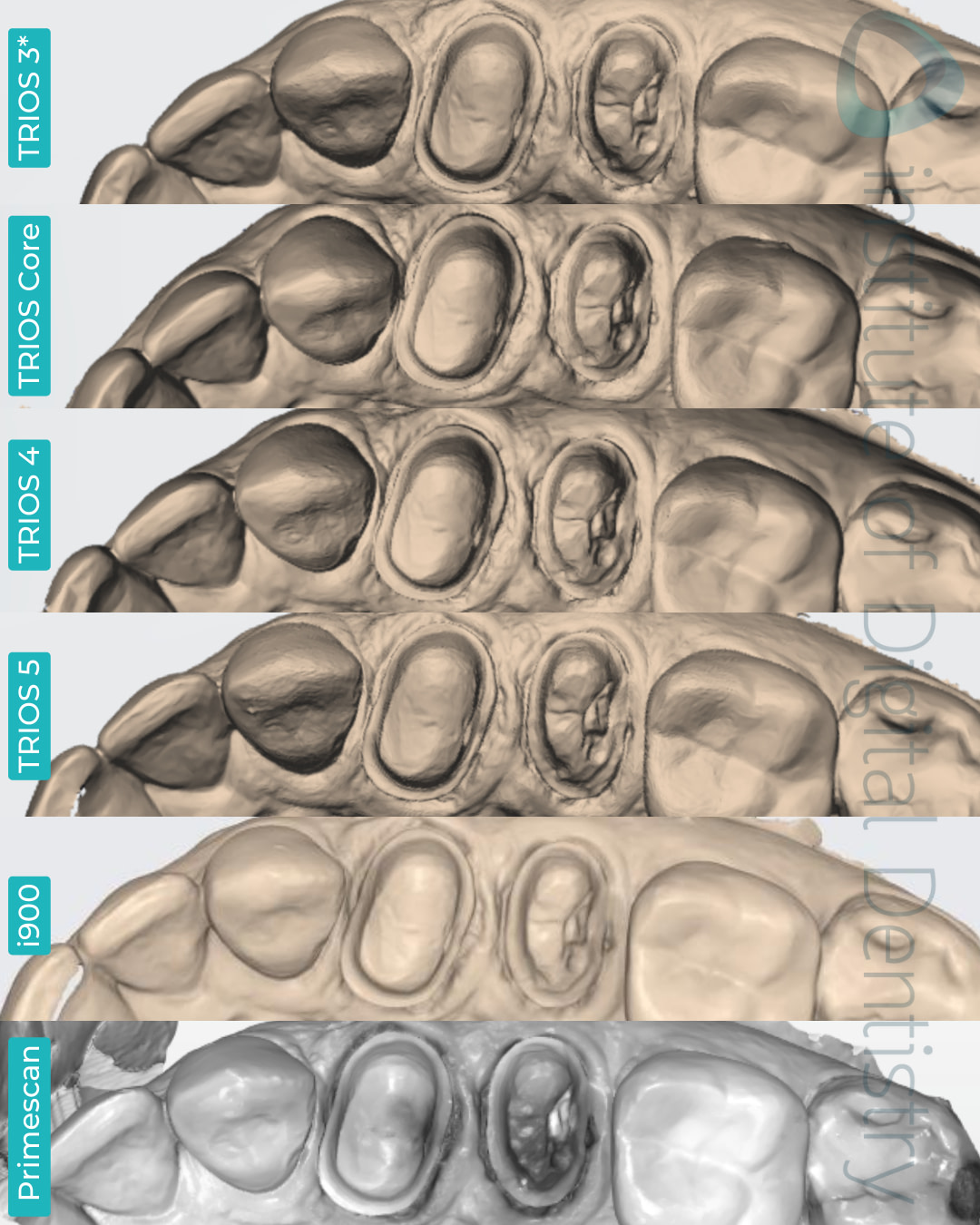
The processed monochromatic scans of the same tooth preparation were captured using six scanners previewed in their native software.
It's apparent that the Primescan does display more detail of the prep quality in this view. It consistently does this when compared to all other scanners.
In terms of the monochrome scans for the TRIOS scanners, there aren’t too many differences between the monochrome scans.
Exported Scans in Third-Party Software
All intraoral scanners have an open architecture that allows scans to be exported and sent to labs.
These scans are usually exported in three formats - STL, PLY or OBJ files.
STL files are exported as monochromatic scans, whereas OBJ and PLY files store color (texture).
Not all intraoral scanners can export OBJ and PLY files, whereas STL files are widely used as the industry's default setting.
This particular set of scanners is capable of exporting scans in these formats:
- Medit i900 - STL, PLY, and OBJ
- TRIOS 3 Updated, TRIOS Core, TRIOS 4, TRIOS 5 - STL, PLY, and DCM
- CEREC Primescan - STL only (unless connected to a lab via DS connect and then PLY can be exported lab side)
Intraoral Scanner | STL | PLY | OBJ | DCM |
|---|---|---|---|---|
TRIOS 3 Updated | 15.1 MB | 6.2 MB | - | 7 MB |
TRIOS Core | 14.1 MB | 5.8 MB | - | 6.7 MB |
TRIOS 4 | 11.7 MB | 4.8 MB | - | 5.8 MB |
TRIOS 5 | 14.3 MB | 5.9 MB | - | 7.6 MB |
Medit i900 | 7.7 MB | 3.2 MB | 7.6 MB | - |
CEREC Primescan | 18.1 MB | - | - | - |
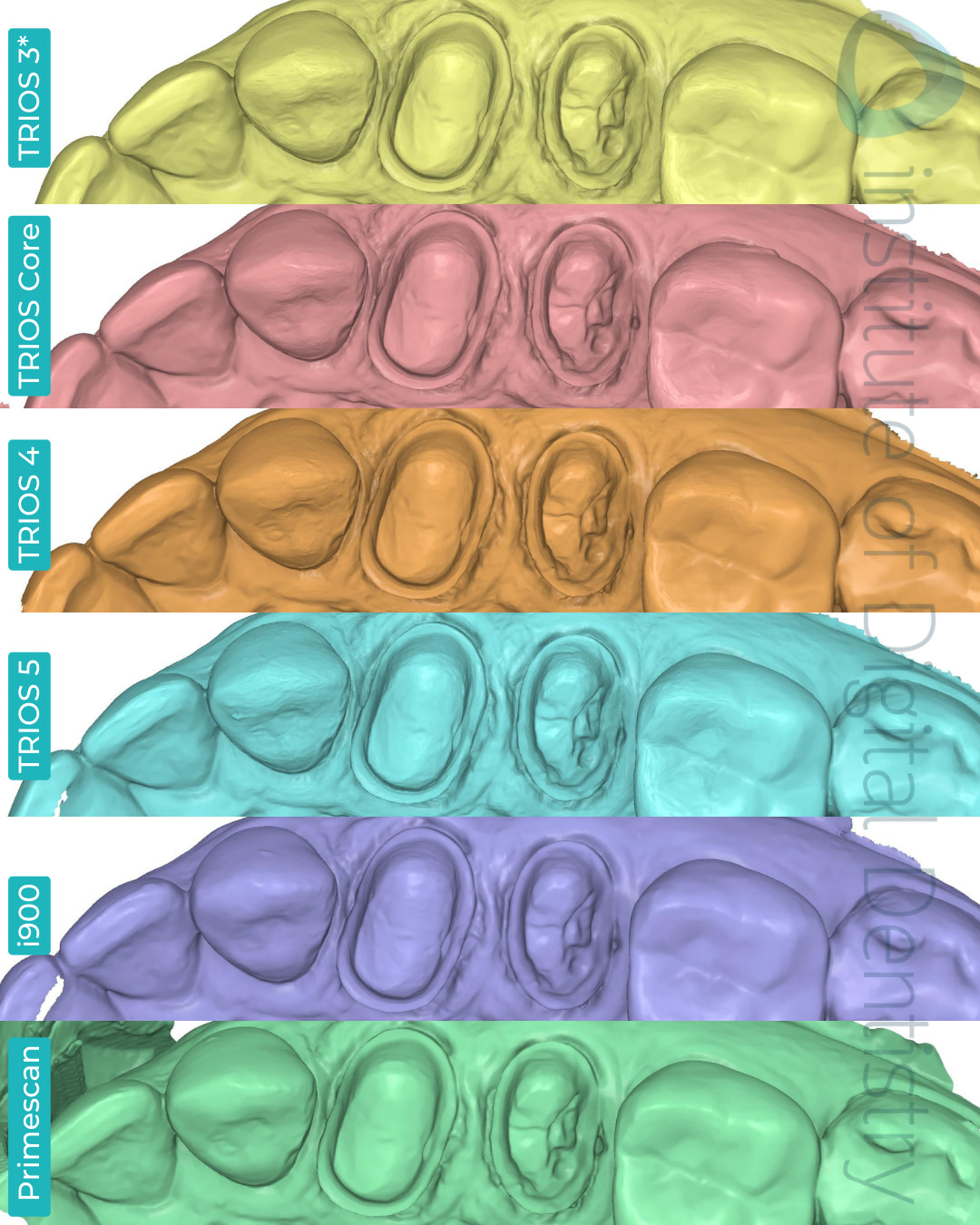
All scans were exported in an STL format and previewed in the Medit Design app.
We can also look at the tessellation mesh of each scan within Medit Design.

Tessellation mesh density of the six scans as previewed in the Medit Design app.
As expected, Primescan possesses the densest tessellation mesh, closely followed by, surprisingly, the updated TRIOS 3, then TRIOS 5, and TRIOS Core’s mesh. TRIOS 5 is 0.2 MB larger and slightly denser than TRIOS Core.
Medit possessed the least dense tessellation mesh, as expected, as it only had an STL file size of 7.7 MB, whereas all the TRIOS files and Primescan were double digits.
Studies investigating the clinical significance of mesh density have yet to be conducted from our understanding. It is important to note that a denser mesh does not necessarily indicate a ‘better scan.’
Let’s take a closer look at the prep margins.


When viewing the preps buccally and lingually, we see that Primescan displays the margin lines more clearly than the other scanners for sure. It does a very crisp margin line.
But the difference in the other non-CEREC scanners is not huge, TRIOS 5 and i900, are also quite sharp.
Dentsply Sirona’s CEREC Primescan is commonly seen as one of the gold standards of intraoral scanners in the dental community. It is regarded as one of the most accurate on the market. In fact I use it literally every clinic day to fabricate same-day crowns and can vouch for its accuracy. It just works.
So, for this reason, we used CEREC Primescan as our point of reference to compare the deviations between the scans. We aligned all six scans on top of each other to see if there were any major deviations that would be clinically significant.

Deviation map of the scans compared to CEREC’s scan and sectional view. There seems to be minimal deviation around the prep area.
Based on the colored deviation key above, we can see that the scan meshes are within 50 microns compared to the scan taken with CEREC Primescan and show little to no deviation around the prep area.
Conclusion
The accuracy in capturing restoration preparation details can vary slightly depending on the clinician's scanning technique and the specific scanner used.
This variation may affect the final restoration margin produced by dental lab technicians.
So, how did you think the latest TRIOS intraoral scanners, the TRIOS 3 updated and TRIOS Core, hold up against Primescan and i900?
Let us know your thoughts.
Leave a comment below about which IOS you’d like us to compare next.

